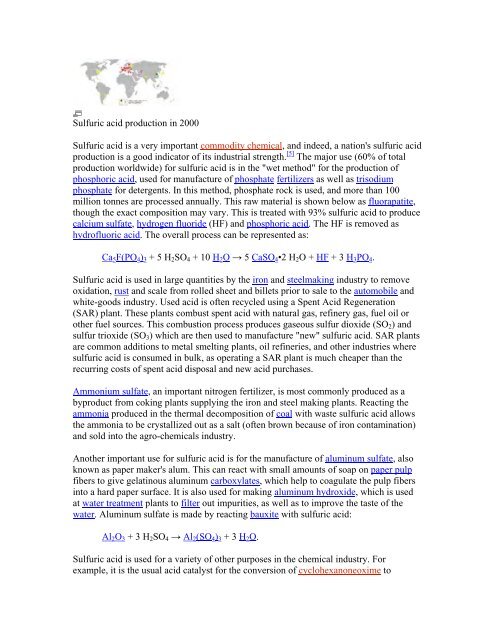Sulfuric acid
Sulfuric acid
Sulfuric acid
- No tags were found...
Create successful ePaper yourself
Turn your PDF publications into a flip-book with our unique Google optimized e-Paper software.
<strong>Sulfuric</strong> <strong>acid</strong> production in 2000<strong>Sulfuric</strong> <strong>acid</strong> is a very important commodity chemical, and indeed, a nation's sulfuric <strong>acid</strong>production is a good indicator of its industrial strength. [5] The major use (60% of totalproduction worldwide) for sulfuric <strong>acid</strong> is in the "wet method" for the production ofphosphoric <strong>acid</strong>, used for manufacture of phosphate fertilizers as well as trisodiumphosphate for detergents. In this method, phosphate rock is used, and more than 100million tonnes are processed annually. This raw material is shown below as fluorapatite,though the exact composition may vary. This is treated with 93% sulfuric <strong>acid</strong> to producecalcium sulfate, hydrogen fluoride (HF) and phosphoric <strong>acid</strong>. The HF is removed ashydrofluoric <strong>acid</strong>. The overall process can be represented as:Ca 5 F(PO 4 ) 3 + 5 H 2 SO 4 + 10 H 2 O → 5 CaSO 4 •2 H 2 O + HF + 3 H 3 PO 4 .<strong>Sulfuric</strong> <strong>acid</strong> is used in large quantities by the iron and steelmaking industry to removeoxidation, rust and scale from rolled sheet and billets prior to sale to the automobile andwhite-goods industry. Used <strong>acid</strong> is often recycled using a Spent Acid Regeneration(SAR) plant. These plants combust spent <strong>acid</strong> with natural gas, refinery gas, fuel oil orother fuel sources. This combustion process produces gaseous sulfur dioxide (SO 2 ) andsulfur trioxide (SO 3 ) which are then used to manufacture "new" sulfuric <strong>acid</strong>. SAR plantsare common additions to metal smelting plants, oil refineries, and other industries wheresulfuric <strong>acid</strong> is consumed in bulk, as operating a SAR plant is much cheaper than therecurring costs of spent <strong>acid</strong> disposal and new <strong>acid</strong> purchases.Ammonium sulfate, an important nitrogen fertilizer, is most commonly produced as abyproduct from coking plants supplying the iron and steel making plants. Reacting theammonia produced in the thermal decomposition of coal with waste sulfuric <strong>acid</strong> allowsthe ammonia to be crystallized out as a salt (often brown because of iron contamination)and sold into the agro-chemicals industry.Another important use for sulfuric <strong>acid</strong> is for the manufacture of aluminum sulfate, alsoknown as paper maker's alum. This can react with small amounts of soap on paper pulpfibers to give gelatinous aluminum carboxylates, which help to coagulate the pulp fibersinto a hard paper surface. It is also used for making aluminum hydroxide, which is usedat water treatment plants to filter out impurities, as well as to improve the taste of thewater. Aluminum sulfate is made by reacting bauxite with sulfuric <strong>acid</strong>:Al 2 O 3 + 3 H 2 SO 4 → Al 2 (SO 4 ) 3 + 3 H 2 O.<strong>Sulfuric</strong> <strong>acid</strong> is used for a variety of other purposes in the chemical industry. Forexample, it is the usual <strong>acid</strong> catalyst for the conversion of cyclohexanoneoxime to
















